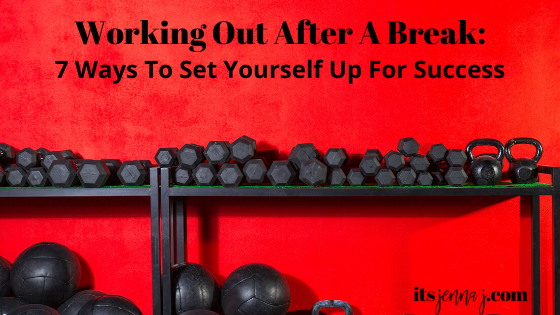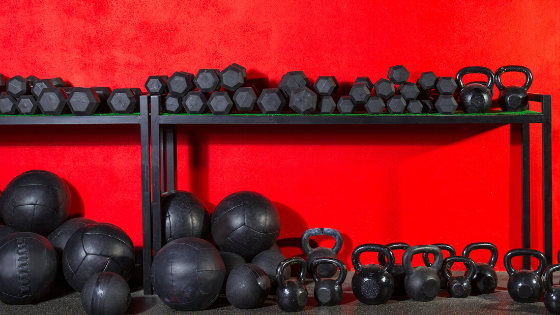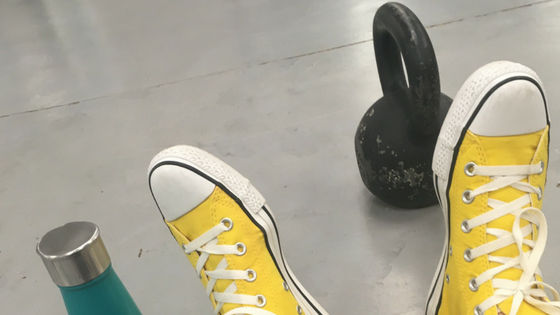Working Out After A Break: 7 Ways To Set Yourself Up For Success
Have you given any thought to what working out is going to look like once we all get back to “normal”? For most of us, quarantine has put a wrench into our workout routine. Maybe you feel like you lost the motivation to exercise, or are just dealing with a different schedule and priorities? You’ve been sick? Or maybe you’ve still been working out but it looks different. You’ve traded your gym membership and weights for bodyweight workouts, yard work, and the occasional online class, because that’s all you have access to.
Chances are you’re also concerned about how this whole situation has affected your body and your fitness?
Whether you’ve gained weight, lost muscle & strength, or just feel out of practice with your usual activities (all totally normal and ok!), it’s important to set yourself up for success as you begin to return to “normal” workouts. The same rules also apply during non-COVID times too, by the way. Like, when you’re coming back from an injury, a long stretch of time off, or simply starting a new style of training.

1. Start at the beginning.
This is why working with a coach or following a program is helpful. When you start at the beginning, whether that’s the beginning of a new program or by testing the waters with the basics on your own, you’re able to rebuild your skills from a strong foundation. Avoid trying to jump right back in where you left off. Being “advanced” at anything doesn’t mean you always do the hardest thing. It means that you are wise enough to know that it’s ok to feel like a beginner sometimes.
2. Let go of expectations.
This is easier said than done. I get it. But if you compare yourself to where you were a few months ago you’ll set yourself for failure and disappointment. I am constantly reminding my clients that progress is not linear. You may have had a few setbacks, but you’ll be able to work through them more successfully if you focus on doing the best you can on any given day.
3. Put form first.
Always, but especially now. Focus on trying to execute each exercise you do well. Think about your alignment and technique and how it feels in your body. Let this be more important than choosing the hardest variation of an exercise or using the heaviest weights. Once your form is solid, you can increase the load and intensity. If you’re working with a trainer in real life, they should be focused on this with you too. And if you’re working with an online coach, send them form check videos!
4. Use Rate of Perceived Exertion to measure difficulty rather than trying to hit a certain number or weight.
Rate of Perceived Exertion (also known as RPE) is a way to measure the difficulty of an exercise/how hard you’re working without using technical calculations. Essentially it’s listening to your body. So instead of trying to lift xx lbs or do xx reps because that’s what you used to do, try to go for an amount that feels similarly difficult. When it comes to adding weight, test the waters with curiosity and presence instead of judgement.
5. Set realistic and achievable goals.
Especially when it comes to when and how often you’re going to work out. For example, if you tend to get busy and distracted throughout the day, plan to do it earlier before other things get in the way. Not a morning person? Early is relative–doesn’t have to be 6am! Remember, life is different now. You had to adapt to a new “normal” when quarantine first hit, and as things start to shift, you’re going to have to do that again. Have patience, and start with goals you’re 90% sure you can achieve. You can always add new challenges later, after you accomplish the original ones.
6. Let strength training complement (not compete with) other things you love to do.
For example: kettlebell swings are great for generating more power if you’re a runner. Push-ups can help you strengthen your yoga practice. Suitcase carries translate to carrying bags of mulch around your yard. Lunges and step ups will make your hikes feel easier. Notice these moments and allow them to coexist. #reasonswhyilift
7. Don’t be afraid to ask for help!
Especially if you’re already paying for it! If you have a coach, make sure you’re fully utilizing all their services. Ask your personal trainer for some tips if you’re struggling with the mindset piece. Ask questions about your form! If you’re a part of a fitness community, reach out to the other members who are likely sharing a similar experience right now. The internet is a powerful connection tool! And if you don’t have a support system, consider hiring a coach or joining an online group program.
Remember that it’s normal for things to feel hard, especially when you’re just getting back into it! Anyone who makes this look easy likely has years of struggle behind them. Or maybe just a whole lot of privilege? In either case, it’s definitely not something that most people are posting about on Instagram. Like:
“Here’s my failed overhead press from today! And by the way, I had these arms even before I started lifting because genetics! Have a great day!”
People just don’t DO that. But it’s the truth. Cut the comparison and focus on doing the best you can for you in the moment, whatever that looks like right now. Remember that it never has to be all-or-nothing. 🙂








One Comment
Comments are closed.